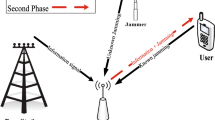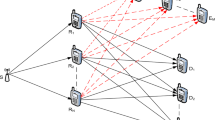Abstract
In this paper, we propose and analyze the integration of source and jammer for a decode-and-forward two-way scheme under physical layer security where the source nodes not only transmit data signals, but also transmit jamming signals to degrade the quality of eavesdropping links, and a selected relay forwards the combined data signals using an XOR operation. In this proposed protocol, the best relay is chosen by the maximum end-to-end achievable secrecy rate, and the secrecy system performance is evaluated by the exact and asymptotic secrecy outage probability over flat and block Rayleigh fading channels. The Monte-Carlo results are presented to verify the theoretical analysis.







Similar content being viewed by others
References
Nosratinia, A., Hunter, T. E., & Hedayat, A. (2004). Cooperative communication in wireless networks. IEEE Communications Magazine, 42, 74–80.
Laneman, J. N., Tse, D. N. C., & Wornell, G. W. (2004). Cooperative diversity in wireless networks: efficient protocols and outage behavior. IEEE Transactions on Information Theory, 50, 3062–3080.
Krikidis, I., Thompson, J., Mclaughlin, S., & Goertz, N. (2008). Amplify-and-forward with partial relay selection. IEEE Communications Letters, 12, 235–237.
Xia, M., & Aissa, S. (2012). Cooperative AF relaying in spectrum-sharing systems: Outage probability analysis under co-channel interferences and relay selection. IEEE Transactions on Communications, 60, 3252–3262.
Ikki, S. S., & Ahmed, M. H. (2010). Performance analysis of adaptive decode-and-forward cooperative diversity networks with best-relay selection. IEEE Transaction on communications, 58, 68–72.
Tourki, K., Yang, H.-C., & Alouini, M.-S. (2011). Accurate outage analysis of incremental decode-and-forward opportunistic relaying. IEEE Transactions on Wireless Communications, 10, 1021–1025.
Ju, M. C., Kim, I.-M., & Kim, D. I. (2012). Joint relay selection and relay ordering for DF-based cooperative relay networks. IEEE Transaction on communications, 60, 908–915.
Duy, T. T., & Kong, H.-Y. (2013). Performance analysis of two-way hybrid decode-and-amplify relaying scheme with relay selection for secondary spectrum access. Wireless Personal Communications, 69, 857–878.
Li, Y., Louie, R. H. Y., & Vucetic, B. (2010). Relay selection with network coding in two-way relay channels. IEEE Transactions on Vehicular Technology, 59, 4489–4499.
Chen, J., Song, L., Han, Z., & Jiao, B. (2011). Joint relay and jammer selection for secure decode-and-forward two-way relay communications. Global Telecommunications Conference GLOBECOM, 2011, 1–5.
Wyner, A. D. (1975). The wire-tap channel. Bell System Technical Journal, 54, 1355–1367.
Leung-Yan-Cheong, S., & Hellman, M. E. (1978). The Gaussian wire-tap channel. IEEE Transaction on Information Theory, 24, 451–456.
Csiszar, I., & Korner, J. (1978). Broadcast channels with confidential messages. IEEE Transactions on Information Theory, 24, 339–348.
Liang, Y., Poor, H. V., & Shamai (Shitz), S. (2008). Secure communication over fading channels. IEEE Transactions on Information Theory, 54, 2470–2492.
Dong, L., Han, Z., Petropulu, A. P., & Poor, H. V. (2010). Improving wireless physical layer security via cooperating relays. IEEE Transactions on Signal Processing, 58, 1875–1888.
Ding, Z., Mai, X., Jianhua, L., & Liu, F. (2012). Improving wireless security for bidirectional communication scenarios. IEEE Transactions on Vehicular Technology, 61, 2842–2848.
Wang, H.-M., Yin, Q., & Xia, X.-G. (2012). Distributed beamforming for physical-layer security of two-way relay networks. IEEE Transactions on Signal Processing, 60, 3532–3545.
Wang, H.-M., Yin, Q., & Xia, X.-G. (2011). Improving the physical-layer security of wireless two-way relaying via analog network coding. Global Telecommunications Conference GLOBECOM, 2011, 1–6.
Krikidis, I. (2010). Opportunistic relay selection for cooperative networks with secrecy constraints. IET Communications, 4, 1787–1791.
Sun, X., Xu, W., Jiang, M., & Zhao, C. (2012). Opportunistic selection for decode-and-forward cooperative networks with secure probabilistic constraints. Wireless Personal Communications, 70, 1633–1652.
Krikidis, I., Thompson, J. S., & McLaughlin, S. (2009). Relay selection for secure cooperative networks with jamming. IEEE Transactions on Wireless Communication, 8, 5003–5011.
Stanojev, I., & Yener, A. (2013). Improving secrecy rate via spectrum leasing for friendly jamming. IEEE Transactions on Wireless Communications, 12, 134–145.
Zhang, R., Song, L., Han, Z., Jiao, B., & Debbah, M. (2010). Physical layer security for two way relay communications with friendly jammers. Global Telecommunications Conference GLOBECOM, 2010, 1–6.
Junsu, K., Ikhlef, A., & Schober, R. (2012). Combined relay selection and cooperative beamforming for physical layer security. Journal of Communications and Networks, 14, 364–373.
Gradshteyn, I. S., Ryzhik, I. M., Jeffrey, A., & Zwillinger, D. (2007). Table of integral, series and products (17th ed.). Amsterdam: Elsevier.
Sakran, H., Shokair, M., Nasr, O., El-Rabaie, S., & El-Azm, A. A. (2012). Proposed relay selection scheme for physical layer security in cognitive radio networks. IET Communications, 6, 2676–2687.
Acknowledgments
This paper was supported by 2014 Special Research Fund of Electrical Engineering of University of Ulsan.
Author information
Authors and Affiliations
Corresponding author
Appendices
Appendix 1: Solving the CDF of RV \(\textit{ASR}_1\) in Formula (25)
In the high SNR \(\gamma \), \(\textit{ASR}_1\) in (25) is rewritten as
Then, the CDF of \(\textit{ASR}_1\) is expressed as
Substituting (52) into (53), we obtain (54) as
Set \({\theta _x} = {2^{3x}}\), \({p_x} = {{\left( {{2^{3x}} - 1} \right) } \big / \gamma }\), \({m_x} = {{\left( {{2^{3x}}a} \right) } \big / {\left( {\gamma \left( {1 - b} \right) } \right) }}\), \({n_x} = {{\left( {{2^{3x}}b} \right) } \big / {\left( {\gamma \left( {1 - a} \right) } \right) }}\), and \({Y_\xi } = \frac{{\omega _4^\xi }}{{\omega _5^\xi }},\,\xi \in \left\{ {1,2} \right\} \), then (54) is rewritten as
where \({f_{{\omega _{31}}}}(x)\), \({F_{\omega _{11}^3}}(x)\), \({F_{\omega _{21}^3}}(x)\) are the probability density functions (PDF) of the RV \({\omega _{31}}\), the CDF of the RVs \(\omega _{11}^3\), and \(\omega _{21}^3\) , respectively, and are given as
The CDF of \({Y_\xi }\) is given as
where \({f_{\omega _4^\xi }}(x)\) and \({f_{\omega _5^\xi }}(x)\) are the PDF of the exponential RVs \(\omega _4^\xi \) and \(\omega _5^\xi \,\), respectively, and are give as
Substituting (59) into (58), we obtain (60) as
From \({F_{{Y_\xi }}}(z)\), the PDF of RV \({Y_\xi }\) is given as
Substituting (56), (57) and (61) into (55), and after some manipulations, the CDF of \(\textit{ASR}_1\) is obtained as
where \(\varGamma \left[ {a,z} \right] \) is the incomplete gamma function and is defined as \(\varGamma (a,z) = \mathop \int \nolimits _z^\infty {t^{a - 1}}{e^{ - t}}dt\) [25, Eq. (8.350.2)].
Appendix 2: Solving the CDF of RV \(\textit{ASR}_i\) in Formula (41)
The CDF of RV \(\textit{ASR}_i\), \(i = \left\{ {1,2,\ldots ,M} \right\} \), is given from (41) as
After some manipulations of (63), the CDF of \(\textit{ASR}_i\) is obtained as
where \({f_{{\omega _{3i}}}}(x)\), \({F_{\omega _{1i}^3}}(x)\), \({F_{\omega _{2i}^3}}(x)\) are the PDF of the RV \({\omega _{3i}}\), the CDF of the RVs \(\omega _{1i}^3\) and \(\omega _{2i}^3\), \(i = \left\{ {1,2,\ldots ,M} \right\} \), respectively, and are obtained as same as (56) and (57).
Then, CDF of \(\textit{ASR}_i\) is obtained as
Appendix 3: Solving Formula (49)
In the high SNR \(\gamma \), (49) is rewritten as
The first component in (66) is given as
where \({F_{\omega _5^1}}(x)\) and \({F_{{\omega _{31}}}}(x)\) are the CDF of the exponential RVs \(\omega _5^1\) and \({\omega _{31}}\), respectively, and are given as \({F_{\omega _5^1}}(x) = 1 - {\lambda _5}{e^{ - {\lambda _5}x}}\) and \({F_{{\omega _{31}}}}(x) = 1 - {\lambda _3}{e^{ - {\lambda _3}x}}\).
Hence, after some manipulations, the first component in (66) is solved as
The second component in (66) is given as
Substituting (61) into (69), after some manipulations, we obtained as
where \(Ei[x]\) is the exponential integral function, \(Ei(x) = - \int _{ - x}^\infty {\left( {{{{e^{ - t}}} \big / t}} \right) } dt\), [25, Eq. (8.211.1)].
Substituting (68) and (70) into (66), we obtains the probability of the correct computation of the secrecy packet \(x_1\) as in (50).
Rights and permissions
About this article
Cite this article
Son, P.N., Kong, H.Y. An Integration of Source and Jammer for a Decode-and-Forward Two-way Scheme Under Physical Layer Security. Wireless Pers Commun 79, 1741–1764 (2014). https://doi.org/10.1007/s11277-014-1956-z
Published:
Issue Date:
DOI: https://doi.org/10.1007/s11277-014-1956-z




